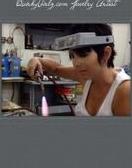I am reminded of the movie “The Witches of Eastwick” when I think about proper stringing materials for handmade jewelry. It is the scene when the pearl necklace breaks, the beads fly across the floor and down the stairs. Calamity ensues when Felicia Alden steps on the beads, falls down the stairs, and breaks her arm.
This is a reminder of how important stringing materials are when purchasing or constructing a handmade necklace or bracelet. If you have ever had a favorite piece of jewelry break, you know all too well how important it is for the jewelry designer to have chosen the correct material to string your necklace or bracelet on.
Considering what type of a design you are going to make and the beads you will be using in your piece will help you to choose your stringing material. If you are using heavier beads, such as semi-precious stone beads, you will want to choose a stronger material. You also need to determine if you will want your design to have movement, be flexible or stiff.
Stringing materials are available in a wide variety of diameters and colors. In order for you to determine what diameter to choose, consider the size of the opening of the smallest bead that you will use in your design.
Because I often design jewelry that is made with semi-precious stone beads, I prefer a 49 strand wire that is coated for durability and flexibility. For pearl strands and other designs that require even more flexibility, or for beads that have smaller openings, I prefer silk cord.
There are many other types of stringing materials to choose from and you will need to determine what style is best for the materials and design you have chosen.
Flexible Beading Wire
Flexible beading wire is composed of multiple strands of fine stainless steel wire with a nylon coating. It comes in several colors and you can decide what color to use based on how much of the wire will be exposed within your design. I recommend that you choose the 49 strand beading wire for designs that has weight and require flexibility. You may choose to use seven strand wire for designs that are not as heavy but still need some flexibility. Remember that the thicker the wire, the stronger it is.
Here is an example of a necklace that is made with flexible wire.
http://www.quirkygirlz.com/catalog/index.php?main_page=product_info&cPath=76_102&products_id=326&zenid=4b63a1583bdb43f6418612beaec535f9
On the back of the package of the wire it will notate the break strength of the wire. This means how much weight it will take before it will break.
Memory Wire
This wire is tempered and remembers its predetermined shape and always retains its coiled form. The best materials are composed of stainless steel, this material is resistant to tarnish and corrosion. You can purchase this material in bracelet, necklace and ring sizes.
Stretch Plastic Cord and Thread
Stretch thread is made of plastic and is very flexible. This would be a good material to choose when making jewelry for children, it is best used for pieces that do not require a clasp. This type of material is fastened by forming a surgeon’s square knot and securing it with glue.
Silk Cord
This type of material must be used with a needle. Used most often for stringing pearls and other small beads or gemstones that have knots between them. Silk cord usually comes with a curved needle that is attached. Though it sounds delicate, silk is one of the strongest natural fibers.
Leather Cord
You may also choose to design your handmade jewelry with leather or suede cord. This requires beads with larger holes and different clasp elements. This stringing material is generally chosen when the material is left exposed within the design.
When you purchase mass produced jewelry, it will often be difficult to determine what type of stringing material was used. With handmade jewelry, the designer will often tell you what type of material is used, and will most often choose higher quality materials.
I hope this post has been helpful and prevents any “Witches of Eastwick” moments from occurring in your life!
I look forward to your comments and suggestions, and I would love to hear your horror stories about the time your favorite necklace or bracelet broke when you were wearing it.
Till next time,
Quirky Girl
http://www.QuirkyGirlz.com

